60+ Rhetorical Situation Examples
A rhetorical situation in English involves the context in which communication occurs, including the speaker, audience, purpose, and the message being conveyed. Understanding a rhetorical situation helps to analyze and create effective communication by considering how these elements interact. For example, a teacher addressing students about the importance of reading uses a different tone and language compared to a politician speaking to voters about policy changes. By recognizing the components of the rhetorical situation, one can tailor their message to achieve the desired impact and engage their audience more effectively.
What is a Rhetorical Situation?
Types of Rhetorical Situation
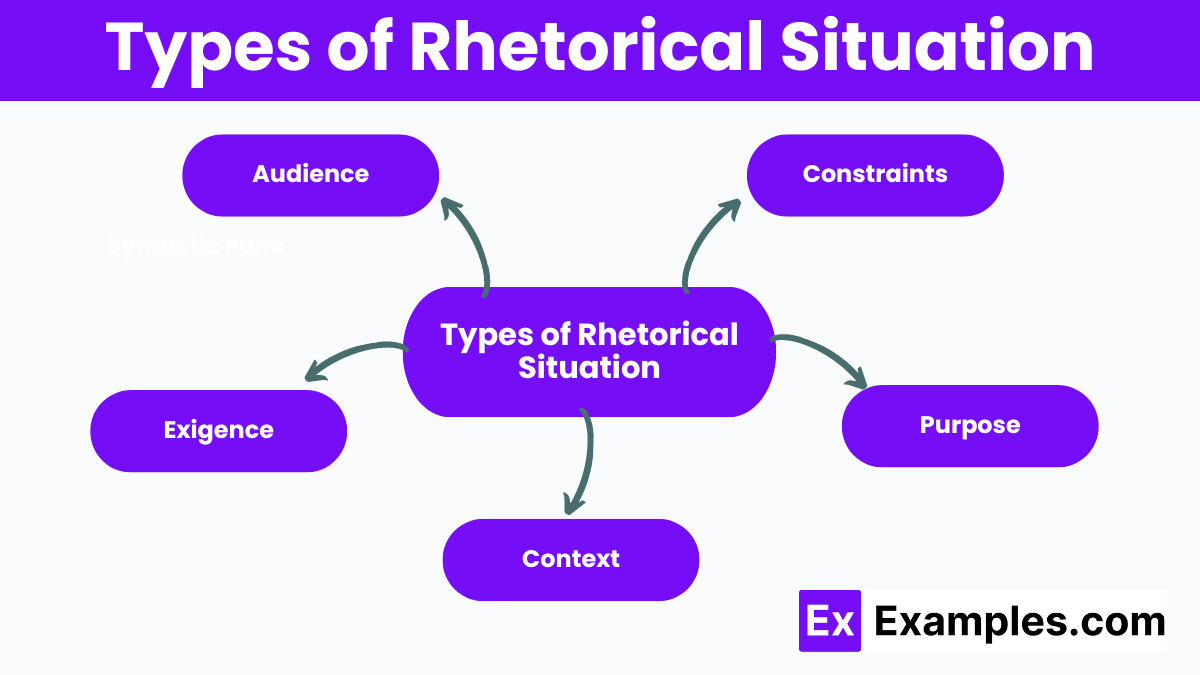
1. Exigence: An exigence is a pressing issue or problem that prompts someone to write or speak. It creates a sense of urgency and necessity for communication. The speaker addresses the exigence to resolve or respond to the situation.
2. Audience: The audience is the group of people who receive the message. They play a crucial role in the rhetorical situation because their characteristics, beliefs, and attitudes influence how the message is crafted and delivered. The speaker tailors the message to engage and persuade the audience effectively.
3. Constraints: Constraints are the factors that limit or shape the communication process. These include the speaker’s credibility, the audience’s preconceptions, the context of the situation, and any external factors that might impact the delivery and reception of the message. The speaker navigates these constraints to convey the message successfully.
4. Purpose: The purpose is the speaker’s intention or goal in delivering the message. It could be to inform, persuade, entertain, or motivate the audience. The speaker’s purpose guides the content, style, and structure of the communication.
5. Context: The context is the environment or situation in which the communication takes place. It includes the time, place, and social conditions that surround the interaction. The speaker considers the context to make the message relevant and appropriate for the circumstances.
Examples of Rhetorical Situation
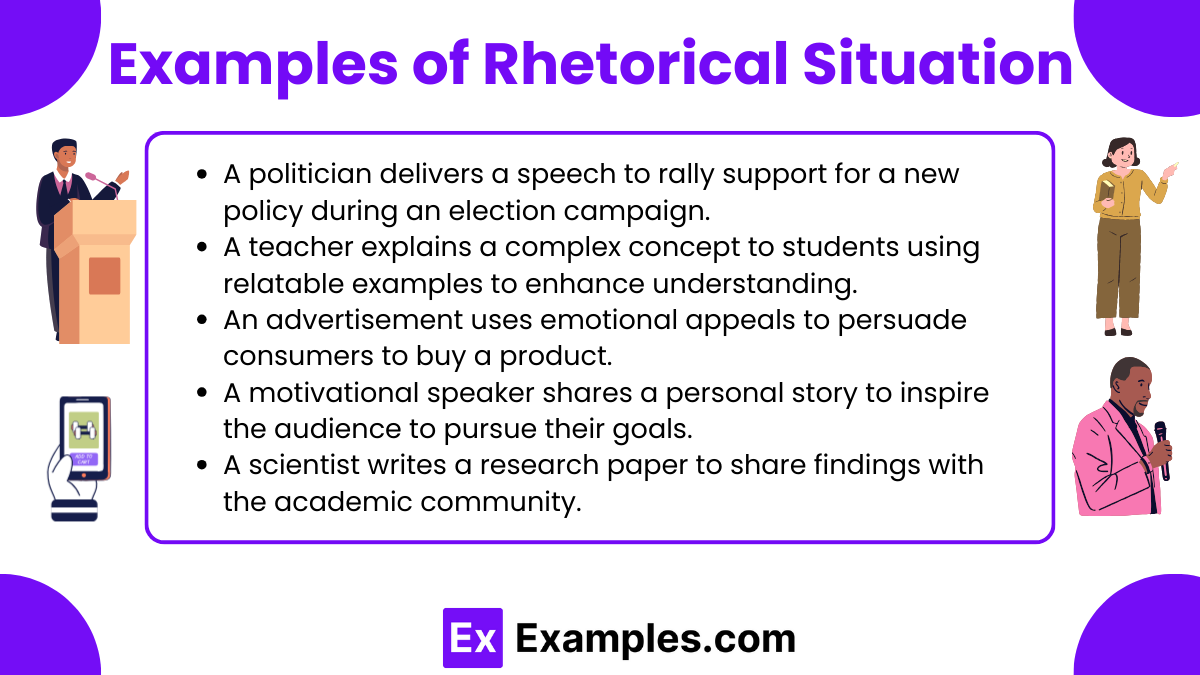
- A politician delivers a speech to rally support for a new policy during an election campaign.
- A teacher explains a complex concept to students using relatable examples to enhance understanding.
- An advertisement uses emotional appeals to persuade consumers to buy a product.
- A lawyer presents evidence and arguments in court to defend their client.
- A scientist writes a research paper to share findings with the academic community.
- A social media influencer creates a post to promote a brand to their followers.
- A parent talks to their child about the importance of honesty after the child tells a lie.
- A public health official holds a press conference to inform the public about safety measures during a pandemic.
- A company CEO gives a presentation to investors to secure funding for a new project.
- An environmental activist writes an op-ed to raise awareness about climate change.
- A wedding officiant delivers a heartfelt speech during the ceremony to celebrate the couple.
- A novelist crafts a story that reflects social issues to engage readers and provoke thought.
- A job applicant writes a cover letter to persuade an employer to offer an interview.
- A motivational speaker shares a personal story to inspire the audience to pursue their goals.
- A blogger writes a post to review and recommend a travel destination.
- A charity organization creates a campaign to encourage donations for disaster relief.
- A film director uses visual and auditory elements to convey a message in a movie.
- A political candidate participates in a debate to present their platform and counter opponents’ arguments.
- A manager holds a meeting to address team performance and set future goals.
- A customer writes a review to express satisfaction or dissatisfaction with a product or service.
Examples of Rhetorical Situation in Sentences
- The teacher’s reminder to the class about the importance of submitting homework on time motivated students to be punctual.
- The politician’s promise to reduce taxes during a campaign speech aimed to gain voter support.
- The environmentalist’s plea for recycling efforts in a community meeting sought to increase participation.
- The doctor’s explanation of treatment options to a patient ensured informed consent.
- The advertisement’s catchy jingle and slogan convinced consumers to try the new product.
- The author’s foreword in a book established the purpose and context for the reader.
- The coach’s pep talk at halftime boosted the team’s morale for the second half of the game.
- The customer’s positive review on a website encouraged others to purchase the product.
- The protestor’s chant during a rally aimed to draw attention to the social issue.
- The job seeker’s tailored cover letter highlighted their skills to match the job description and impress the employer.
Examples of Rhetorical Situation in Everyday Life
- A friend convinces another friend to watch a movie by describing its exciting plot.
- A parent explains the benefits of eating vegetables to their child during dinner.
- A neighbor writes a note to request a reduction in noise from a loud party next door.
- A customer complains to a store manager about poor service to receive better treatment.
- A person gives a toast at a wedding to celebrate the couple’s love and commitment.
- A citizen writes a letter to a local representative to advocate for better public transportation.
- A coach motivates the team with a speech before a big game to boost their confidence.
- A chef explains a recipe to their cooking class to teach proper techniques and ingredients.
- A person creates a social media post to raise awareness about a community event.
- A worker negotiates a raise with their boss by highlighting their achievements and contributions.
Examples of Rhetorical Situation For Students
- A student writes an essay to persuade the teacher to allow a retake of a failed test.
- A student gives a presentation in class to explain a historical event to their peers.
- A student asks a teacher for an extension on a project due to personal circumstances.
- A student joins a debate team to argue a position on a controversial topic.
- A student creates a poster to promote a school club meeting to attract new members.
- A student writes a reflection paper to express their thoughts on a class assignment.
- A student participates in a group discussion to share their viewpoint on a novel.
- A student emails a professor to ask for clarification on a confusing lecture topic.
- A student advocates for healthier lunch options to the school administration.
- A student leads a study group session to help classmates prepare for an exam.
Examples of Rhetorical Situation in Literature
- In “To Kill a Mockingbird,” Atticus Finch’s closing argument in the trial to persuade the jury.
- In “1984,” Winston’s diary entries to express his dissent against the oppressive regime.
- In “The Great Gatsby,” Nick Carraway narrates the story to provide his perspective on Gatsby’s life.
- In “Pride and Prejudice,” Elizabeth Bennet’s conversations with Darcy to reveal her wit and independence.
- In “Romeo and Juliet,” Juliet’s soliloquy to express her deep love and conflict.
- In “Animal Farm,” Old Major’s speech to inspire the animals to revolt against their human oppressors.
- In “Hamlet,” Hamlet’s “To be or not to be” soliloquy to ponder life and death.
- In “The Catcher in the Rye,” Holden Caulfield’s narration to convey his inner turmoil and critique of society.
- In “Moby-Dick,” Ishmael’s introduction to provide context for the whaling voyage.
- In “The Scarlet Letter,” Hester Prynne’s silence and dignity in the face of public shaming.
1. Rhetorical Situation Analysis Example
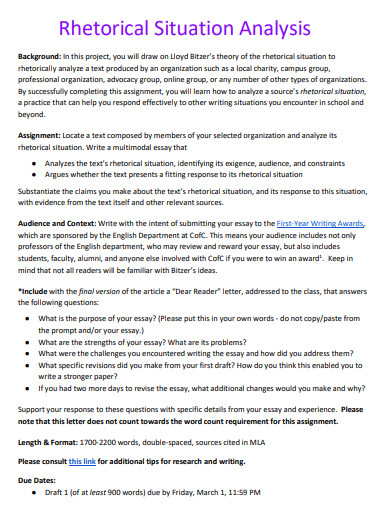
english.cofc.edu
2. Rhetorical Situation Triangle Example
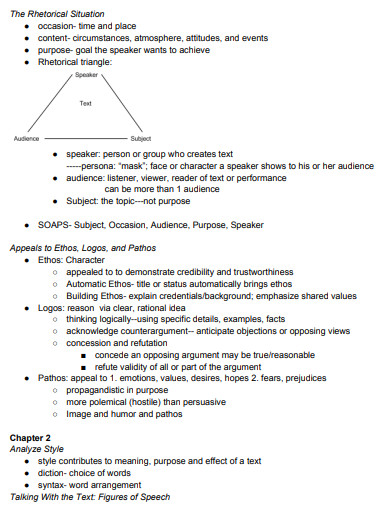
apsubjects.weebly.com
3. Rhetorical Situation and Rhetorical Appeals
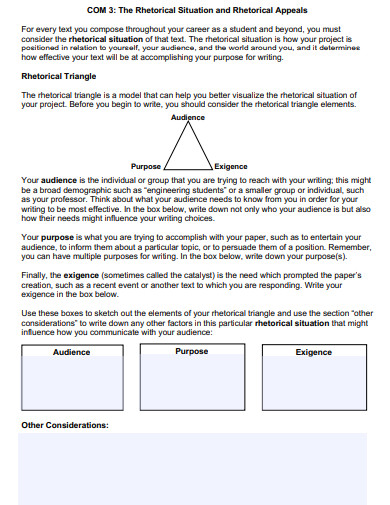
mtsu.edu
4. College Rhetorical Situation Example
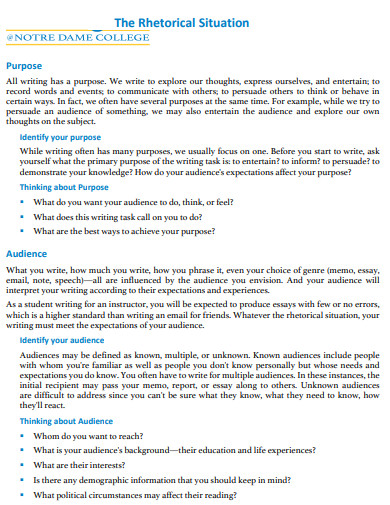
ndc.learninghouse.com
5. Genre Rhetorical Situation
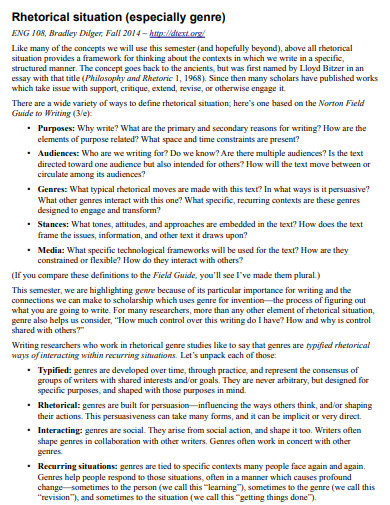
dtext.org
Purpose of Rhetorical Situation
The purpose of a rhetorical situation is to create effective communication tailored to a specific audience and context. It helps the speaker or writer understand the factors that influence how the message is crafted and received. By analyzing the rhetorical situation, the communicator can address the audience’s needs, expectations, and attitudes. This leads to clearer, more persuasive, and impactful messages. Understanding the purpose, audience, context, and constraints allows the communicator to achieve their goals, whether it’s to inform, persuade, entertain, or inspire the audience.
How to Use Rhetorical Situation
A rhetorical situation is the context in which communication occurs, involving an interaction between the speaker, the audience, the message, and the purpose.
Identify the Exigence
Recognize the issue or problem that prompts the need for communication. Determine what needs to be addressed and why it is important. This helps you focus on the main purpose of your message.
Analyze the Audience
Understand who your audience is, including their beliefs, values, expectations, and knowledge. Tailor your message to resonate with them, considering what will engage and persuade them effectively.
Consider the Context
Evaluate the environment or situation in which the communication occurs. Take into account the time, place, and social conditions. This helps you adapt your message to be relevant and appropriate for the circumstances.
Recognize Constraints
Identify any limitations or factors that might influence how your message is received. These could include cultural norms, the audience’s preconceptions, or your own credibility. Navigate these constraints to enhance your communication.
Clarify the Purpose
Define your goal in delivering the message. Whether you aim to inform, persuade, entertain, or inspire, having a clear purpose guides the content, style, and structure of your communication.
Craft the Message
Develop your message with the exigence, audience, context, constraints, and purpose in mind. Use appropriate language, tone, and evidence to effectively convey your ideas and achieve your communication goals.
Tips For Using Rhetorical Situation
- Understand Your Audience: Research your audience’s demographics, interests, and values. Tailor your message to meet their needs and expectations. This helps create a connection and makes your message more persuasive.
- Define Your Purpose Clearly: Be clear about what you want to achieve with your communication. Whether you aim to inform, persuade, entertain, or inspire, a well-defined purpose guides the structure and content of your message.
- Analyze the Context: Consider the time, place, and social environment in which you are communicating. Adapt your message to fit the context, making it more relevant and impactful for your audience.
- Address the Exigence: Identify the pressing issue or problem that prompts your communication. Highlight the urgency and importance of the topic to engage your audience’s attention and interest.
- Be Aware of Constraints: Recognize any limitations or challenges that might affect your communication. This includes the audience’s preconceptions, cultural norms, or your own credibility. Plan how to navigate these constraints effectively.
- Use Appropriate Tone and Style: Match your tone and style to the audience and context. A formal tone may be suitable for academic or professional settings, while a conversational tone might work better for informal or personal communications.
- Provide Clear and Compelling Evidence: Support your arguments with relevant facts, examples, and evidence. This enhances your credibility and helps persuade your audience.
- Engage Emotionally: Use emotional appeals to connect with your audience on a deeper level. Stories, anecdotes, and vivid descriptions can evoke emotions and make your message more memorable.
- Be Concise and Focused: Keep your message clear and to the point. Avoid unnecessary details or tangents that might distract from your main purpose.
- Reflect and Revise: After delivering your message, reflect on its effectiveness. Seek feedback and be willing to revise your approach based on what worked well and what didn’t. Continuous improvement enhances your communication skills.
What is rhetorical situation and purpose?
A rhetorical situation is the context of communication involving the speaker, audience, message, and purpose. Its purpose is to create effective communication tailored to the specific context.
What is the original rhetorical situation?
The original rhetorical situation refers to the classical context in which Aristotle defined rhetoric as the art of persuasion in public speaking.
What questions should you ask yourself when considering your rhetorical situation?
Ask yourself about the audience, purpose, context, constraints, and the exigence prompting your communication.
What defines a rhetorical phrase?
A rhetorical phrase is a statement or question crafted to persuade or provoke thought, often using figures of speech.
What is rhetoric in a rhetorical situation?
Rhetoric in a rhetorical situation is the art of using language effectively to persuade or inform an audience within a specific context.
What are the 3 parts of a rhetorical situation?
The three parts of a rhetorical situation are the speaker, the audience, and the message.
What is genre in rhetorical situation?
Genre in a rhetorical situation refers to the category or type of communication, such as speeches, essays, or advertisements, each with specific conventions.
What is an example of rhetoric?
An example of rhetoric is Martin Luther King Jr.’s “I Have a Dream” speech, which used powerful language to inspire and persuade.
What is a rhetorical problem?
A rhetorical problem is an issue or challenge in communication that requires a strategic approach to effectively address or resolve.
Which of the following best defines the term rhetorical situation?
A rhetorical situation is the interplay of speaker, audience, message, purpose, and context in a communication event.
60+ Rhetorical Situation Examples
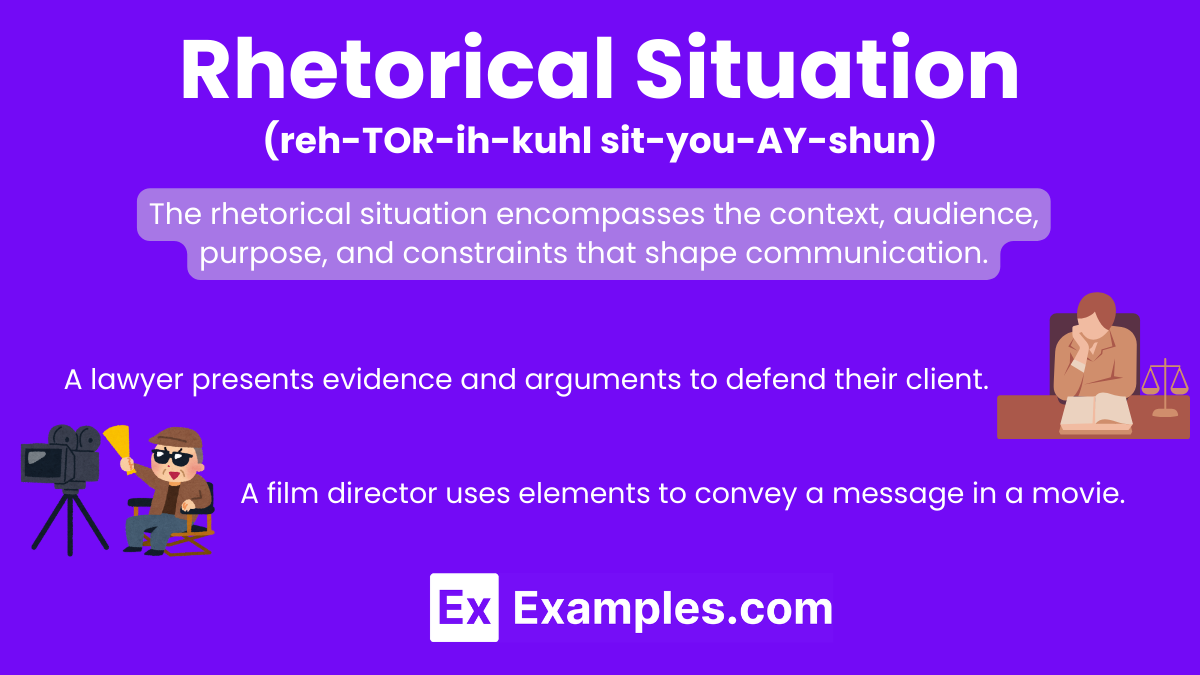
A rhetorical situation in English involves the context in which communication occurs, including the speaker, audience, purpose, and the message being conveyed. Understanding a rhetorical situation helps to analyze and create effective communication by considering how these elements interact. For example, a teacher addressing students about the importance of reading uses a different tone and language compared to a politician speaking to voters about policy changes. By recognizing the components of the rhetorical situation, one can tailor their message to achieve the desired impact and engage their audience more effectively.
What is a Rhetorical Situation?
A rhetorical situation is the context in which communication occurs, involving an interaction between the speaker, the audience, the message, and the purpose. It considers the circumstances that prompt the need for communication and influences how the message is conveyed and received. Key components include the speaker’s intentions, the audience’s expectations, the message’s content, and the context or environment in which the communication takes place.
Types of Rhetorical Situation
1. Exigence: An exigence is a pressing issue or problem that prompts someone to write or speak. It creates a sense of urgency and necessity for communication. The speaker addresses the exigence to resolve or respond to the situation.
2. Audience: The audience is the group of people who receive the message. They play a crucial role in the rhetorical situation because their characteristics, beliefs, and attitudes influence how the message is crafted and delivered. The speaker tailors the message to engage and persuade the audience effectively.
3. Constraints: Constraints are the factors that limit or shape the communication process. These include the speaker’s credibility, the audience’s preconceptions, the context of the situation, and any external factors that might impact the delivery and reception of the message. The speaker navigates these constraints to convey the message successfully.
4. Purpose: The purpose is the speaker’s intention or goal in delivering the message. It could be to inform, persuade, entertain, or motivate the audience. The speaker’s purpose guides the content, style, and structure of the communication.
5. Context: The context is the environment or situation in which the communication takes place. It includes the time, place, and social conditions that surround the interaction. The speaker considers the context to make the message relevant and appropriate for the circumstances.
Examples of Rhetorical Situation
A politician delivers a speech to rally support for a new policy during an election campaign.
A teacher explains a complex concept to students using relatable examples to enhance understanding.
An advertisement uses emotional appeals to persuade consumers to buy a product.
A lawyer presents evidence and arguments in court to defend their client.
A scientist writes a research paper to share findings with the academic community.
A social media influencer creates a post to promote a brand to their followers.
A parent talks to their child about the importance of honesty after the child tells a lie.
A public health official holds a press conference to inform the public about safety measures during a pandemic.
A company CEO gives a presentation to investors to secure funding for a new project.
An environmental activist writes an op-ed to raise awareness about climate change.
A wedding officiant delivers a heartfelt speech during the ceremony to celebrate the couple.
A novelist crafts a story that reflects social issues to engage readers and provoke thought.
A job applicant writes a cover letter to persuade an employer to offer an interview.
A motivational speaker shares a personal story to inspire the audience to pursue their goals.
A blogger writes a post to review and recommend a travel destination.
A charity organization creates a campaign to encourage donations for disaster relief.
A film director uses visual and auditory elements to convey a message in a movie.
A political candidate participates in a debate to present their platform and counter opponents’ arguments.
A manager holds a meeting to address team performance and set future goals.
A customer writes a review to express satisfaction or dissatisfaction with a product or service.
Examples of Rhetorical Situation in Sentences
The teacher’s reminder to the class about the importance of submitting homework on time motivated students to be punctual.
The politician’s promise to reduce taxes during a campaign speech aimed to gain voter support.
The environmentalist’s plea for recycling efforts in a community meeting sought to increase participation.
The doctor’s explanation of treatment options to a patient ensured informed consent.
The advertisement’s catchy jingle and slogan convinced consumers to try the new product.
The author’s foreword in a book established the purpose and context for the reader.
The coach’s pep talk at halftime boosted the team’s morale for the second half of the game.
The customer’s positive review on a website encouraged others to purchase the product.
The protestor’s chant during a rally aimed to draw attention to the social issue.
The job seeker’s tailored cover letter highlighted their skills to match the job description and impress the employer.
Examples of Rhetorical Situation in Everyday Life
A friend convinces another friend to watch a movie by describing its exciting plot.
A parent explains the benefits of eating vegetables to their child during dinner.
A neighbor writes a note to request a reduction in noise from a loud party next door.
A customer complains to a store manager about poor service to receive better treatment.
A person gives a toast at a wedding to celebrate the couple’s love and commitment.
A citizen writes a letter to a local representative to advocate for better public transportation.
A coach motivates the team with a speech before a big game to boost their confidence.
A chef explains a recipe to their cooking class to teach proper techniques and ingredients.
A person creates a social media post to raise awareness about a community event.
A worker negotiates a raise with their boss by highlighting their achievements and contributions.
Examples of Rhetorical Situation For Students
A student writes an essay to persuade the teacher to allow a retake of a failed test.
A student gives a presentation in class to explain a historical event to their peers.
A student asks a teacher for an extension on a project due to personal circumstances.
A student joins a debate team to argue a position on a controversial topic.
A student creates a poster to promote a school club meeting to attract new members.
A student writes a reflection paper to express their thoughts on a class assignment.
A student participates in a group discussion to share their viewpoint on a novel.
A student emails a professor to ask for clarification on a confusing lecture topic.
A student advocates for healthier lunch options to the school administration.
A student leads a study group session to help classmates prepare for an exam.
Examples of Rhetorical Situation in Literature
In “To Kill a Mockingbird,” Atticus Finch’s closing argument in the trial to persuade the jury.
In “1984,” Winston’s diary entries to express his dissent against the oppressive regime.
In “The Great Gatsby,” Nick Carraway narrates the story to provide his perspective on Gatsby’s life.
In “Pride and Prejudice,” Elizabeth Bennet’s conversations with Darcy to reveal her wit and independence.
In “Romeo and Juliet,” Juliet’s soliloquy to express her deep love and conflict.
In “Animal Farm,” Old Major’s speech to inspire the animals to revolt against their human oppressors.
In “Hamlet,” Hamlet’s “To be or not to be” soliloquy to ponder life and death.
In “The Catcher in the Rye,” Holden Caulfield’s narration to convey his inner turmoil and critique of society.
In “Moby-Dick,” Ishmael’s introduction to provide context for the whaling voyage.
In “The Scarlet Letter,” Hester Prynne’s silence and dignity in the face of public shaming.
1. Rhetorical Situation Analysis Example

english.cofc.edu
2. Rhetorical Situation Triangle Example

apsubjects.weebly.com
3. Rhetorical Situation and Rhetorical Appeals

mtsu.edu
4. College Rhetorical Situation Example

ndc.learninghouse.com
5. Genre Rhetorical Situation

dtext.org
Purpose of Rhetorical Situation
The purpose of a rhetorical situation is to create effective communication tailored to a specific audience and context. It helps the speaker or writer understand the factors that influence how the message is crafted and received. By analyzing the rhetorical situation, the communicator can address the audience’s needs, expectations, and attitudes. This leads to clearer, more persuasive, and impactful messages. Understanding the purpose, audience, context, and constraints allows the communicator to achieve their goals, whether it’s to inform, persuade, entertain, or inspire the audience.
How to Use Rhetorical Situation
A rhetorical situation is the context in which communication occurs, involving an interaction between the speaker, the audience, the message, and the purpose.
Identify the Exigence
Recognize the issue or problem that prompts the need for communication. Determine what needs to be addressed and why it is important. This helps you focus on the main purpose of your message.
Analyze the Audience
Understand who your audience is, including their beliefs, values, expectations, and knowledge. Tailor your message to resonate with them, considering what will engage and persuade them effectively.
Consider the Context
Evaluate the environment or situation in which the communication occurs. Take into account the time, place, and social conditions. This helps you adapt your message to be relevant and appropriate for the circumstances.
Recognize Constraints
Identify any limitations or factors that might influence how your message is received. These could include cultural norms, the audience’s preconceptions, or your own credibility. Navigate these constraints to enhance your communication.
Clarify the Purpose
Define your goal in delivering the message. Whether you aim to inform, persuade, entertain, or inspire, having a clear purpose guides the content, style, and structure of your communication.
Craft the Message
Develop your message with the exigence, audience, context, constraints, and purpose in mind. Use appropriate language, tone, and evidence to effectively convey your ideas and achieve your communication goals.
Tips For Using Rhetorical Situation
Understand Your Audience: Research your audience’s demographics, interests, and values. Tailor your message to meet their needs and expectations. This helps create a connection and makes your message more persuasive.
Define Your Purpose Clearly: Be clear about what you want to achieve with your communication. Whether you aim to inform, persuade, entertain, or inspire, a well-defined purpose guides the structure and content of your message.
Analyze the Context: Consider the time, place, and social environment in which you are communicating. Adapt your message to fit the context, making it more relevant and impactful for your audience.
Address the Exigence: Identify the pressing issue or problem that prompts your communication. Highlight the urgency and importance of the topic to engage your audience’s attention and interest.
Be Aware of Constraints: Recognize any limitations or challenges that might affect your communication. This includes the audience’s preconceptions, cultural norms, or your own credibility. Plan how to navigate these constraints effectively.
Use Appropriate Tone and Style: Match your tone and style to the audience and context. A formal tone may be suitable for academic or professional settings, while a conversational tone might work better for informal or personal communications.
Provide Clear and Compelling Evidence: Support your arguments with relevant facts, examples, and evidence. This enhances your credibility and helps persuade your audience.
Engage Emotionally: Use emotional appeals to connect with your audience on a deeper level. Stories, anecdotes, and vivid descriptions can evoke emotions and make your message more memorable.
Be Concise and Focused: Keep your message clear and to the point. Avoid unnecessary details or tangents that might distract from your main purpose.
Reflect and Revise: After delivering your message, reflect on its effectiveness. Seek feedback and be willing to revise your approach based on what worked well and what didn’t. Continuous improvement enhances your communication skills.
What is rhetorical situation and purpose?
A rhetorical situation is the context of communication involving the speaker, audience, message, and purpose. Its purpose is to create effective communication tailored to the specific context.
What is the original rhetorical situation?
The original rhetorical situation refers to the classical context in which Aristotle defined rhetoric as the art of persuasion in public speaking.
What questions should you ask yourself when considering your rhetorical situation?
Ask yourself about the audience, purpose, context, constraints, and the exigence prompting your communication.
What defines a rhetorical phrase?
A rhetorical phrase is a statement or question crafted to persuade or provoke thought, often using figures of speech.
What is rhetoric in a rhetorical situation?
Rhetoric in a rhetorical situation is the art of using language effectively to persuade or inform an audience within a specific context.
What are the 3 parts of a rhetorical situation?
The three parts of a rhetorical situation are the speaker, the audience, and the message.
What is genre in rhetorical situation?
Genre in a rhetorical situation refers to the category or type of communication, such as speeches, essays, or advertisements, each with specific conventions.
What is an example of rhetoric?
An example of rhetoric is Martin Luther King Jr.’s “I Have a Dream” speech, which used powerful language to inspire and persuade.
What is a rhetorical problem?
A rhetorical problem is an issue or challenge in communication that requires a strategic approach to effectively address or resolve.
Which of the following best defines the term rhetorical situation?
A rhetorical situation is the interplay of speaker, audience, message, purpose, and context in a communication event.


